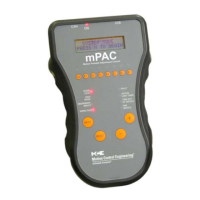User Interface
4-28 Manual # 42-02-2P24
CNP Contactor Proof Input - Monitors the normal condition of motor/start contactors and will
shut the car down if the contactor fails to make or break contact properly. Generates a Con-
tactor Proofing Redundancy Failure message.
CR1-CR8 Car call card reader. Used to enable car call registration to secured front landings. Bypassed
during fire service Phase II operation.
CR1R-CR8R Car call card reader, rear. Used to enable car call registration to secured rear landings.
Bypassed during fire service Phase II operation.
CRO Car call card reader override. When active, car calls may be registered without restriction.
CTF Car to floor Input - Used to return the car to a previously selected floor. The return floor is
selected using CAR TO FLOOR RETURN FLOOR in the EXTRA FEATURES MENU. When acti-
vated, this input will cause the car to immediately become non-responsive to hall calls, and
will prevent registration of new car calls. Depending upon the setting of Retain Calls, car
calls registered prior to activation of the CTF input will be serviced before, or retained for
service after, recall. Please refer to “RETAIN CALLS ON CTL / CTF?” on page 4-48.
CTL Car-to-Lobby Input - Used to return the car to the lobby floor. When activated, this input
will cause the car to immediately become non-responsive to hall calls, and will prevent the
registration of new call calls. Depending upon the setting of Retain Calls, car calls registered
prior to activation of the CTL input will be serviced before, or retained for service after,
recall. Please refer to “RETAIN CALLS ON CTL / CTF?” on page 4-48.
CTST Capture for Test Input - Causes the car to bypass Hall Calls and disable gongs. Car Calls will
still be answered and allowed to be entered.
CWI Counterweight Input. Used in conjunction with EDS and EQI inputs for ANSI and modified
California Earthquake Operation. This input tells the computer that the counterweight has
moved horizontally beyond normal limits. Activation of this input while a car is in flight will
cause an emergency stop. When the car moves to a landing after stopping, it will move in a
direction away from the counterweight (historical activity of EDS input determines which
direction). For ANSI, continuous activation of CWI is monitored (this information is used to
determine if the car will be allowed to run “normally” at reduced speed). For California, CWI
is monitored to determine if the car will be allowed to run on fire service or hospital emer-
gency service.
Please refer to “ASME EARTHQUAKE/CALIF EARTHQUAKE” on page 4-48.
DCL Door Close Limit Input - Associated switch opens when the car door is approximately 1 inch
from being closed, causing input to go low. Opening the door approximately 1 inch will
reapply power to the DCL input as the switch makes up.
DCLC Doors Closed Contact Input - When active (high), indicates doors are closed on Retiring
CAM (RETCAM) jobs. Since the doors do not lock until the car is ready to move, the com-
puter needs to see this input to know when the doors are closed.
DCLR Doors Closed Contact Input Rear - When active (high) indicates rear doors are closed on
Retiring CAM (RETCAM) jobs. Since the doors do not lock until the car is ready to move, the
computer needs to see this input to know when the doors are closed.
DFI Drive Fault Input - The fault output of the drive may be connected to this input for drive
fault detection and recording.
DHLD Door Hold Input - Activates DHO output to open and hold doors for the period the input is
active plus the DLHD timer value. Please refer to “DOOR HOLD INPUT TIMER (Range: 0-240
Seconds)” on page 4-24. Pressing the door close or a car call button will cancel DHLD time.
Fire Service disables the input.
DHLDR DHLD for Rear Doors - See description of DHLD.
DLI Dispatch Load Input - A load weigher is typically connected to this input. When the input is
activated, door dwell time will be curtailed when the elevator has an up direction at the
Lobby Floor.
Table 4.6 Spare Inputs Menu Options
Spare Inputs Menu Options

